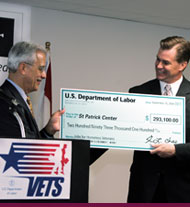
 |
|
|

Transforming Government |
While mini-grants effectively tap into the services provided by small and novice nonprofit organizations, they carry a higher administrative burden for the government. As the Department of Labor (DOL) found early on with its Grassroots Grants program, despite the benefits of mini-grants, managing large numbers of small grantees across the nation can become inefficient. Intermediary model grants help address this challenge by placing a large portion of the administrative responsibilities on larger, more mature intermediary organizations.
Under an intermediary model, grants are made to a large nonprofit organization, educational institution, or other entity. These intermediary organizations use their grant funds to provide smaller awards to faith-based and community-based nonprofit organizations. In addition to the subawards, intermediary organizations are responsible for providing technical support to subawardees and ensuring full compliance with all government regulations, data collection, and other grant requirements. In many cases, intermediaries provide training to help build the organizational strengths and enhance the program performance of subawardees.
The U.S. Department of Justice’s Faith-Based and Community Rural Pilot Program is built on this model, as are DOL’s Workforce Investment Board Intermediary Grants. The Compassion Capital Fund’s Demonstration Program is also designed as an intermediary grant model. To date, 112 grants have been made to intermediary organizations through this program, which have turned into 4,100 faith-based and community-based subawardees in 47 states and the District of Columbia.
A similar intermediary model is used by another program, the Communities Empowering Youth program, in the Compassion Capital Fund. Instead of bringing together subawardees after the larger organization received the award, the organization with the most capacity brings together a group of other organizations with less capacity and describes their partnership as a part of the application to the Federal government for funding. On being awarded funding, the lead organization works with its partners to build capacity in both funding and training. This coalition practice within the intermediary model also involves smaller organizations.